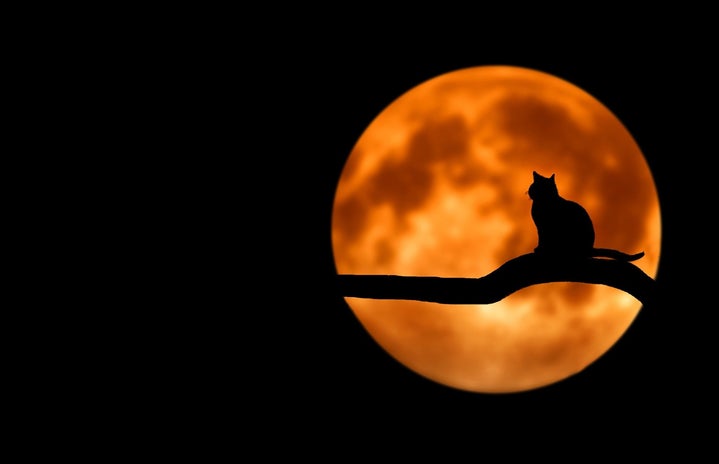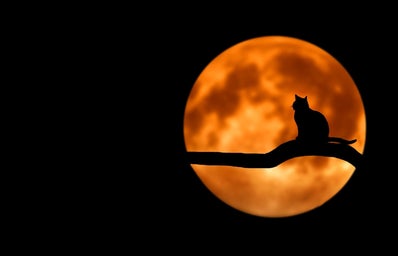Note: Trigger Warning for mention of sexual assault – skip the first paragraph of the second section if needed
Halloween is a holiday phenomenon that has spread its reach throughout multiple continents. People of all ages dressing in costumes, candy, parties, movies, and more, have all become a staple for the month of October. However “spooky season” has a more enriched history than meets the eye. While the themes of transformation and the line between the living and the dead have remained, the ancient forms of Halloween were much different.
The Festival of Samhain
The beginnings of the Halloween traditions can be traced back to pre-Christian Ireland, and possibly Scotland, with the Celtic festival of Samhain (pronounced Saw-wen or Soo-when). The festival of Samhain, which loosely translates to “summer’s end,” is a Celtic New Year festival that celebrates the end of the harvest season. The Celts believed that the veil between the living and the dead (especially the recently passed) was at its thinnest point during this time. A bonfire was lit on the Hill of Tlachtga (pronounced Clack-da), or the Hill of the Ward, around October 31st. A bonfire was lit in response on the Hill of Tara, another sacred spot, to signal the start of the festival; this practice can be traced back to 2,000 years ago. Some traditions included stocking up supplies for winter, feasts and drinking, slaughtering cattle, and disposing of bones in “bone-fires,” which later became known as bonfires. Kind spirits were welcome to join the festivities, but since there were possible spirits who had been wronged by the living, disguises were encouraged. People would darken their faces with ashes from the fires, which later developed into wearing full masks, this practice was known as “guising.”
All Hallow’s Eve
Unfortunately, much of what we know about ancient Celtic culture and pagan practices are through surviving documents of Christian scribes who came to Celtic lands to spread their religion. When Christianity came to Ireland in the 5th century, they would often take the Celtic pagan stories and morph them into fitting a Christian narrative in order to promote conversion. This includes the story of Tlachtga, who was a daughter of a powerful druid, who gave birth to triplets on the hill that shares her name, before dying after childbirth. It was said that she was raped by Simon Magus, a magician who’s confrontation with St. Peter is told in the Bible. The inclusion of Simon Magus was said to be a later addition from the Christians, in order to establish the figure of Tlachtga as being on the “Christian side.” Another way the Catholics were said to Christianize this festival was through Pope Gregory III’s decision to move All Saints Day to November 1st, creating All Hallow’s Eve on October 31st. All Hallow’s Eve became a night of vigil and prayer in preparation for the feast of All Saints. However some Celtic folklore remained involved, and one story created what became one of the most well-known Halloween traditions: the Jack-O-Lantern.
Stingy Jack was said to be a drunkard con-man who managed to trick the devil into banning him from hell, but since he lived a sinful life he was not allowed in heaven either. After Jack’s death, his spirit would roam the land carrying a lantern made out of a turnip with a hot ember inside for light. On All Hallow’s Eve, the Irish would carve faces into turnips and place a candle inside, so they would be protected from spirits like Stingy Jack. Irish immigrants switched from turnips to pumpkins upon moving to the US because they were more abundant and easier to carve.
All Hallow’s Eve, while mainly a Christian holiday, gained influences from multiple cultures. Bonfires were still lit, although now in the name of Christian heroes, but a celebration of the changing seasons also remained. In the 16th century, the practice of “souling” became popular. The poor would go knocking on doors asking for “soul cakes” in return for prayer. This tradition came from the Catholic belief of purgatory, and that a soul would linger there if not elevated by prayer. Another tradition stemmed from Britain, after a failed assassination attempt of King James I by a Catholic dissident group. A man called Guy Fawkes was the one who was caught, which led to a Protestant tradition of “Guy Fawkes Night” in early November. Bonfires were lit, drinking was encouraged, images of the pope were hanged in effigy, and children would go house to house wearing masks, pushing an effigy of Fawkes in a wheelbarrow, begging for money and treats, and would threaten vandalism if refused.
Modern-Day Halloween
The Protestant celebration of the mocking of Guy Fawkes (including anti-Catholic sermons during the day) was celebrated in the US colonies up until the Revolution. The rituals that had been established for the Irish with All Hallow’s Eve, including Jack-O-Lanterns and souling, appeared in the US during the mass Irish migration of the potato famine of the 1840s. While Guy Fawkes night was no longer celebrated, the tradition of vandalism continued around the end of October, although it transitioned from being anti-Catholic to include everyone. That brings us to the story of Kansas woman Elisabeth Krebs. In the early 1900s, she was tired of the vandalism that plagued her house every year, so she orchestrated a party that involved her entire town in order to tire out the young people. It included a costume contest, a band, food, and even a parade. It worked to curb the vandalism, and news of her success spread to other towns who began implementing her idea in their own communities. By the end of the 1920’s, “mischief night,” or the night of Halloween, still held a lot of problems of vandalism and mayhem in the US and Canada. In 1927, a newspaper from Alberta, Canada wrote an article about kids going door to door using the phrase “trick or treat.” If they were given candy, the home-owners were left alone for the night. This tradition, as well as Mrs. Krebs’ party was well implemented as traditions in North America from the 1950s onward, and what we know and love as Halloween came to be.
While Halloween is now considered a secular holiday, you can still see drops of ancient tradition here and there. From the Jack-O-Lanterns, to costumes and masks, the themes of transformation, and even death, can still be seen through the classics of Halloween. So go carve your pumpkins and dress up, or else Stingy Jack might come to get you.
Source:
https://www.worldhistory.org/article/1456/history-of-halloween/


